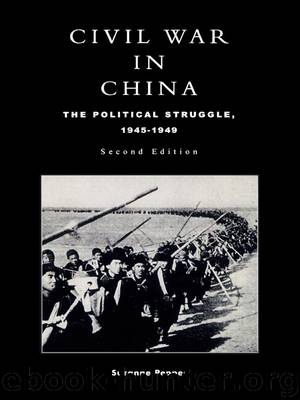Civil War in China by Suzanne Pepper

Author:Suzanne Pepper
Language: eng
Format: epub
ISBN: 9780742573659
Publisher: Rowman & Littlefield Publishers
Published: 2013-06-24T16:00:00+00:00
ARGUMENTS AND INSTRUCTIONS
Party documents told roughly the same story as did Radio Yenan, with two exceptions. The documents presented the relationship between land reform and peasant participation in the war effort in considerably more complex terms. And the claims were frequently interspersed with “must” and “should”, making it difficult to ascertain where exhortation left off and declarations of achievement began.
The Tasks
The style of warfare developed by the Chinese Communists is well known. The reliance on an extensive network of popular support for their military operations continued after 1945, even though guerrilla warfare as such played a much less important role during the 1945-49 period than during the anti-Japanese resistance. Virtually all of the claims concerning the relationship between land reform and the peasants’ participation in the “patriotic self-defense war” came from areas threatened by the advancing Government armies. In such areas, peasant participation referred to the mobilization of the population to guarantee the supply of grain and manpower needed to sustain the war effort. Such mobilization called for the following:
1. The organization of several thousand men per hsien, ideally between 20,000 and 25,000, into militia units. The people’s militia performed a direct supporting role for the front line units of the regular army, being responsible for sentry duty, diversionary activities, harassing the enemy’s rear, garrisoning newly occupied areas, surrounding small points occupied by the enemy, and assisting civilians in the war zones with transporting military supplies, moving the wounded, escorting prisoners-of-war, and the destruction or construction of local installations. The militia was also responsible for protecting local Party and government organizations, guarding prisoners, suppressing local reactionary activities, exposing enemy agents, and keeping communications lines open.
2. The chief task of the local self-defense corps was to guarantee the transport of grain, ammunition, and other military supplies to the front, and the transfer of captured war materiel and the wounded to the rear. The self-defense units were organized in the war zones at the village and ch’ü levels, with the hsien governments responsible for overall coordination and direction. In each village, the self-defense unit was responsible for investigating the manpower, animal power, and material capabilities of every household and, on the basis thereof, for organizing military transport teams, teams of stretcher-bearers, mules, carters, boats, et cetera. All able-bodied civilian men between the ages of sixteen and fifty-five were obliged to participate in such transport work as needed by the regular army.
3. The women’s associations were, among other things, responsible for maintaining a sentry post system for the interrogation of inter-village travellers. The women were also supposed to help with first aid and hospital work, to develop handicraft and other production in support of the war effort, and to encourage young men to volunteer during military recruiting campaigns.
4. Skilled workers were responsible for the maintenance of postal and telecommunications systems and public roads.
5. Cultural teams did front line and rear propaganda work aimed at developing the understanding and willingness of the people to support the war effort.
6. The youth associations mobilized their members to perform rear service work and to join the army.
Download
This site does not store any files on its server. We only index and link to content provided by other sites. Please contact the content providers to delete copyright contents if any and email us, we'll remove relevant links or contents immediately.
| Arms Control | Diplomacy |
| Security | Trades & Tariffs |
| Treaties | African |
| Asian | Australian & Oceanian |
| Canadian | Caribbean & Latin American |
| European | Middle Eastern |
| Russian & Former Soviet Union |
The Secret History by Donna Tartt(18943)
The Social Justice Warrior Handbook by Lisa De Pasquale(12165)
Thirteen Reasons Why by Jay Asher(8841)
This Is How You Lose Her by Junot Diaz(6831)
Weapons of Math Destruction by Cathy O'Neil(6213)
Zero to One by Peter Thiel(5730)
Beartown by Fredrik Backman(5671)
The Myth of the Strong Leader by Archie Brown(5456)
The Fire Next Time by James Baldwin(5379)
How Democracies Die by Steven Levitsky & Daniel Ziblatt(5169)
Promise Me, Dad by Joe Biden(5112)
Stone's Rules by Roger Stone(5051)
A Higher Loyalty: Truth, Lies, and Leadership by James Comey(4904)
100 Deadly Skills by Clint Emerson(4877)
Rise and Kill First by Ronen Bergman(4739)
Secrecy World by Jake Bernstein(4698)
The David Icke Guide to the Global Conspiracy (and how to end it) by David Icke(4655)
The Farm by Tom Rob Smith(4464)
The Doomsday Machine by Daniel Ellsberg(4449)
